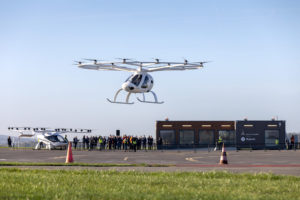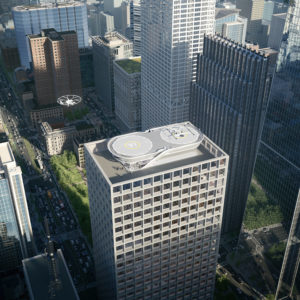Infra
How ground infrastructure for eVTOL aircraft is starting to take shape | Business Airport International

Words by Mark Broadbent
Thousands of eVTOL aircraft have been ordered by airlines and charter firms. According to McKinsey, US$7 billion was invested in future air mobility in 2021 and US$3 billion last year.
Verified Market Research predicts that the eVTOL aircraft market could be worth U$34.9 billion by 2030.
Vertiports are needed to enable commercial passenger operations for eVTOL aircraft. Kevin Cox, CEO of Ferrovial Vertiports, part of Ferrovial Airports, a division of global infrastructure operator Ferrovial believes eVTOL aircraft will be especially relevant for business aviation.
Cox says, “eVTOL aircraft are designed to provide fast, convenient connections so they will benefit the business aviation market. Some vertiports will be in city centers so business aviation passengers will be able to transfer from their airport/airfield straight into a downtown area or between different transport hubs.
“eVTOLs will also operate between cities. Business aviation passengers will benefit from fast connections which avoid congestion and are sustainable with no carbon emissions and minimal noise.”
Addison Ferrell, director of Skyports Infrastructure, which designs, builds and operates take-off and landing infrastructure for eVTOL aircraft says, “Vertiports will be closer to where people live, work and spend their time because eVTOL aircraft will be quieter than helicopters.
“Vertiports will be much smaller and unobtrusive than traditional aviation infrastructure, ranging from a small two-stand vertiport of around 4,000m2 (43,000ft2)to a large eight-stand vertiport of around 13,000m2 (140,000ft2). This includes both the airfield and buildings.
“The reduced size and noise levels and the operational capabilities of an eVTOL aircraft mean there is more flexibility about their location than traditional infrastructure. Vertiports will prioritize convenience and connectivity.
“Most operators are targeting from arrival at the vertiport to departure of the eVTOL aircraft within 15 minutes, followed by a quick flight over congested areas and then a smooth last-mile transition onto your final destination.”
Operational challenges
eVTOL aircraft pose several challenges for vertiport designers. Ferrell says, “The range of eVTOL aircraft is shorter than that of helicopters, so we expect that charging will need to take place during most turnarounds.
“eVTOL aircraft cannot hover for long periods of time without quickly depleting battery reserves, limiting their flexibility to hold during approach if a final approach and take-off area is unavailable. These factors require ground operations that are much more precise and coordinated than most existing heliports and non-hub airports can provide.
“Also, higher volumes and operational cadence require more efficient and robust operational plans and controls.”
Cox says, “eVTOL flights will be most effective if they operate at high frequency with minimal turnaround times for battery charging and maintenance. Therefore, a vertiport must be designed to enable this type of efficient operation. Reduced passenger dwell time is also critical so check-in and security procedures will have to be simplified.
“Vertiports will need to meet or exceed all government noise regulations where they are located. They will also need to be designed to meet or exceed local, regional, and national regulations for fire safety including those related to battery storage, recharging or operations. Operating sustainably with green technologies and construction methods will help with seamless integration with the surrounding environment.”
Planning issues
A regulatory framework for vertiports is developing. In March 2022 EASA published initial prototype technical specifications for vertiports covering physical characteristics, obstacles, visual aids, lights and markings, and concepts for safe flight and landing. In May 2023 the FAA issued a concept of operations and the UK Civil Aviation Authority intends to publish vertiport technical requirements in 2024.
As the requirements for vertiports firm up, there are a number of actions airports can take in preparation. Farrell says, “The most important step is to make a provision for eVTOL aircraft in their masterplans. This includes addressing electric power capacity, as well as space for ground operations.
“Based on demand and operational factors, some airports may have the opportunity to host eVTOL operations sooner than others, but it is wise to start the planning sooner rather than later given the long lead times. We can work with airports to support planning.”
Cox says, “Airports and airlines are already creating partnerships with eVTOL companies and vertiport operators. Business aviation operators need to assess how eVTOLs can benefit their business via connections that are quicker, quieter, and more sustainable than other transport options and which may generate new traffic for their operation.
“They need to assess the practical requirements of building a vertiport alongside their existing operation either inside or outside the airport perimeter.”
Safety standards

“Vertiport networks will be a combination of new-build locations and existing infrastructure adapted for eVTOL use. In both cases, there are new operations, technologies, and ways of thinking required,” says Farrell.
“Vertiports must operate safely for take-off and landing of flights and for charging and maintaining eVTOL aircraft lithium batteries,” says Cox.
“They must integrate the necessary technology to provide a seamless passenger experience. The digitalization of processes to create time efficiencies will be crucial at security check-in and baggage handling for example. Vertiports will need to be located where eVTOLs can operate effectively and reliably, so weather and climate conditions, altitude and visibility must all be considered.”
Cox believes vertiports “must be good neighbors” to ensure their operations are “seamlessly integrated into the fabric of their environment, both from an airspace and land use perspective”. Sustainable building and construction are pre-requisites for their development, he says.
Technology backbone
Vertiports will also require new equipment. Farrell says, “Vertiports will need a technology backbone to support operations. Our Vertiport Automation System can give capabilities at each node of the vertiport network.”
The Vertiport Automation System (VAS) includes a resource management and scheduling system providing dynamic slot booking and a vertiport status feed. A situational awareness system fuses ground sensor data and airspace data to visualize traffic and a passenger identity management system enables passenger access to the vertiport. Data sharing with fleet operators will enable them to optimize the passenger experience.
Skyports is combining proprietary technology and existing solutions for VAS and vertiport technology. “The approach we take depends on several factors, including whether there is an existing off-the-shelf solution, the level of control of a given piece of technology that we require, and requirements for the ultimate ownership of the technology,” Farrell says.
“We do not want to reinvent the wheel. We want to ensure that we are always selecting the technology with the greatest value-add. Where a solution already exists, we undergo extensive due diligence to understand how the technology can be used alongside our own solutions, often working very closely with business partners to tweak their technology to suit our needs.
“An example is how we are working with OneSky to leverage their unmanned traffic management visualization services for our ongoing projects. We are also helping OneSky understand how they can enhance their product to meet our needs.”
Skyports Infrastructure has also tested various technologies at its Skyports London Heliport (SLH) near Canary Wharf in London, one of only two private heliports in the city. The location provides the kind of urban, live flight environment for which most eVTOL aircraft are designed.
Systems tested at SLH so far include a weather system so operators can view weather information and predictions in real time. Others include VHF ground-to-air radio for listening to air traffic control, an ADS-B receiver for airspace visualization, CCTV and an airside situational awareness camera system, as well as a noise monitor to quantify community noise pollution commitments.
Passenger-orientated designs

Ferrovial’s Cox explains the company’s vertiport design approach is “agnostic”, meaning that the facilities it works on “can serve the three primary eVTOL aircraft passengers business models that we foresee – intracity, intra-airline and intercity passenger services – and be adaptable for different-size aircraft and, over time, alternative propulsion systems and new missions,” he says.
“Vertiports must be constructed not only for the first generation of eVTOL aircraft, but for future aircraft as battery technology and their size and capabilities evolve, and future propulsion technologies are brought to market such as hydrogen. In short, the facilities must be future proofed to the greatest extent possible.
“We are working with leading industry partners to develop agnostic vertiports, collaborating with top architects, engineers, manufacturers and operators,” Cox adds.
In June 2023, Ferrovial announced a partnership with real-estate developer Milligan to identify and develop sites for urban air mobility operations in the UK.
Cox believes that vertiports can and wherever feasible should be integrated with other transport networks. He says, “It is likely eVTOL aircraft operators would want to serve business aviation airports, but it will depend on the specific market, passenger demand, competing transport options, and suitable land availability.”
In November 2022 Skyports announced a Memorandum of Understanding with private airport operator Corporación América Airports to plan the development and deployment of vertiport infrastructure in Latin America. In March 2023 Sheikh Mohammed bin Rashid Al Maktoum of Dubai approved the company’s vertiport design.
“By working alongside the urban air mobility market now, business aviation will be able to benefit from this innovative transport mode when it takes off,” says Cox.







:max_bytes(150000):strip_icc()/roundup-writereditor-loved-deals-tout-f5de51f85de145b2b1eb99cdb7b6cb84.jpg)


